It is vital to ensure you are keeping up with the cleaning of your Nebulizer. Be sure to clean the device in a dust-free and smoke-free space away from open windows. Be sure to keep it far from the floor and from areas where people might clean or dust. It’s an excellent idea always to keep an extra nebulizer and mask or mouthpiece.
What is the term “Nebulizer?
A nebulizer transforms liquid medicine into tiny droplets (in mist or aerosol form), then inhaled via the mouthpiece or mask. Nebulizers can give a variety of medications. The medications and moisture can aid in reducing breathing issues like wheezing. They also help in releasing the lungs.
Nebulizers can be used instead of other types of inhalers. The Nebulizer is driven through an air compressor connected to any electrical outlet.
How often should you change the filters for nebulizers?
Typically the nebulizer filter must be replaced every six months.
How to Clean a Nebulizer
Cleaning your Nebulizer properly will help remove any bacteria and debris that could create clogs or cause infections. Here are some tips to ensure you clean your Nebulizer’s systems.
Designate an Area for Cleaning and Storage
Select a location to clean the Nebulizer and store equipment. The site you choose must be clean, dry, and free of smoke or dust. Well-lit lighting can allow you to discern dirt and debris inside the Nebulizer and make it easy to scrub it.
Your cleaning and storage area must be close to the water supply and should contain fresh, lint-free, clean towels (such as paper towels) to dry the equipment. Always make sure you use fresh water and replace your towels regularly.
Know When to Clean Nebulizer Parts
A proper nebulizer cleaning is vital to ensure the best results of your treatment for respiratory problems. Certain parts of your Nebulizer have to be cleaned after each usage, while others need periodic maintenance every few months. Here are some tips to adhere to:
Nebulizer Cup. Rinse thoroughly with warm water following each use to eliminate any remaining medication. After rinsing the nebulizer container, shake it gently to get rid of any extra fluid. Then, please place it in a dry, clean area to let it air dry.
Washing Your Nebulizer Cup and Mouthpiece or Mask. Use gentle dish soap to clean your mouthpiece and mask daily to eliminate any dirt or other contaminants. Don’t wash or rinse the tubing or compressor for the Nebulizer. Reassemble the unit and turn on the compressor. The airflow will allow you to dry all components.
Disinfecting Your Nebulizer Cup and Mouthpiece or Mask. Make sure to clean your Nebulizer’s cup, mouthpiece, and mask regularly by the manufacturer’s instructions. Utilize disinfecting solutions that the maker recommends. Don’t use aggressive chemicals, as there is a possibility that you could inhale harmful leftovers after the next step. Incubate the parts in the mixture for about 20 minutes. After that, rinse them under a constant stream of warm water. Remove any excess water and let the machine air dry. Reassemble the unit and switch on the compressor to dry the Nebulizer.
Cleaning After Treatments
After each treatment, remove the nebulizer cup, mask, or mouthpiece. Clean these components using warm water. You don’t need to scrub the tubing connecting the Nebulizer and the compressor. When you’re rinsing it clean, shake off any excess water and put the components on a dry, clean towel. Let the parts air dry completely.
Do I wash and disinfect the nebulizer tubing?
There are several ways to clean and disinfect the nebulizer tubing. One method is to use water that is boiling. Boil water, then pour it into the tubing until it is clear. Allow the tubing to cool before making use of it again. Another option would be using a home disinfectant such as Lysol and Clorox. Put the disinfectant in the spray bottle and spray the tubing numerous times. Allow the tubing to dry before reusing it.
